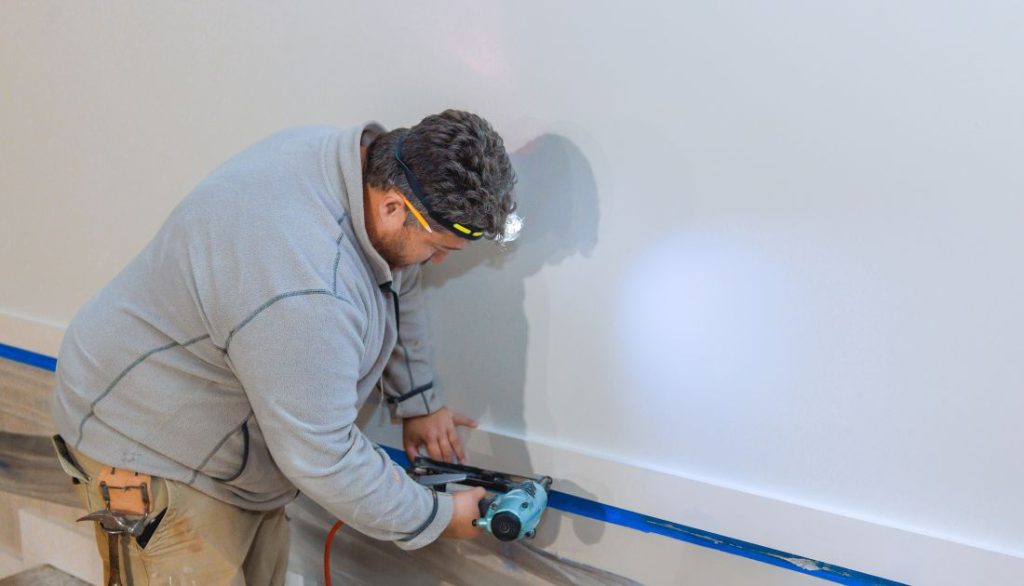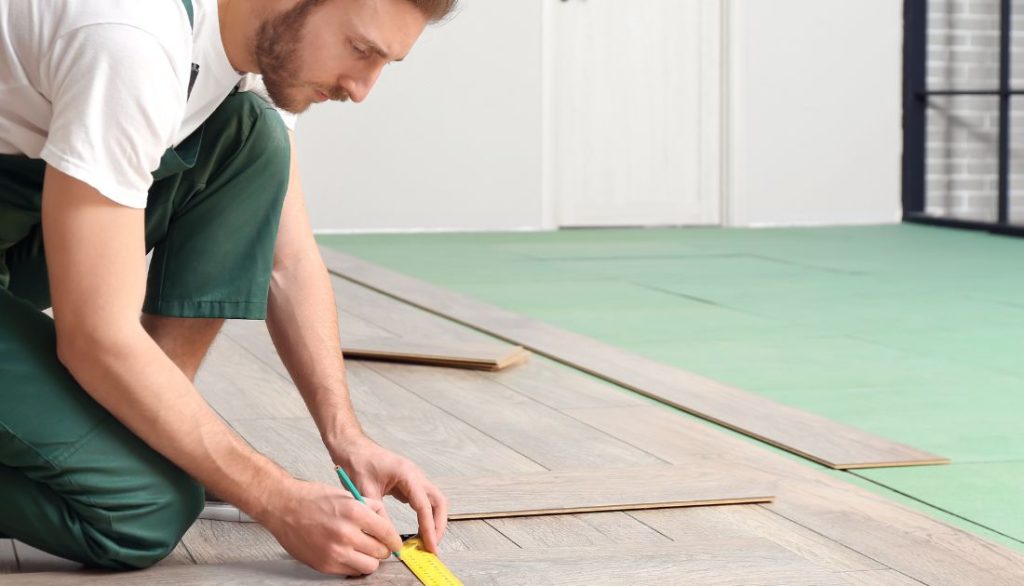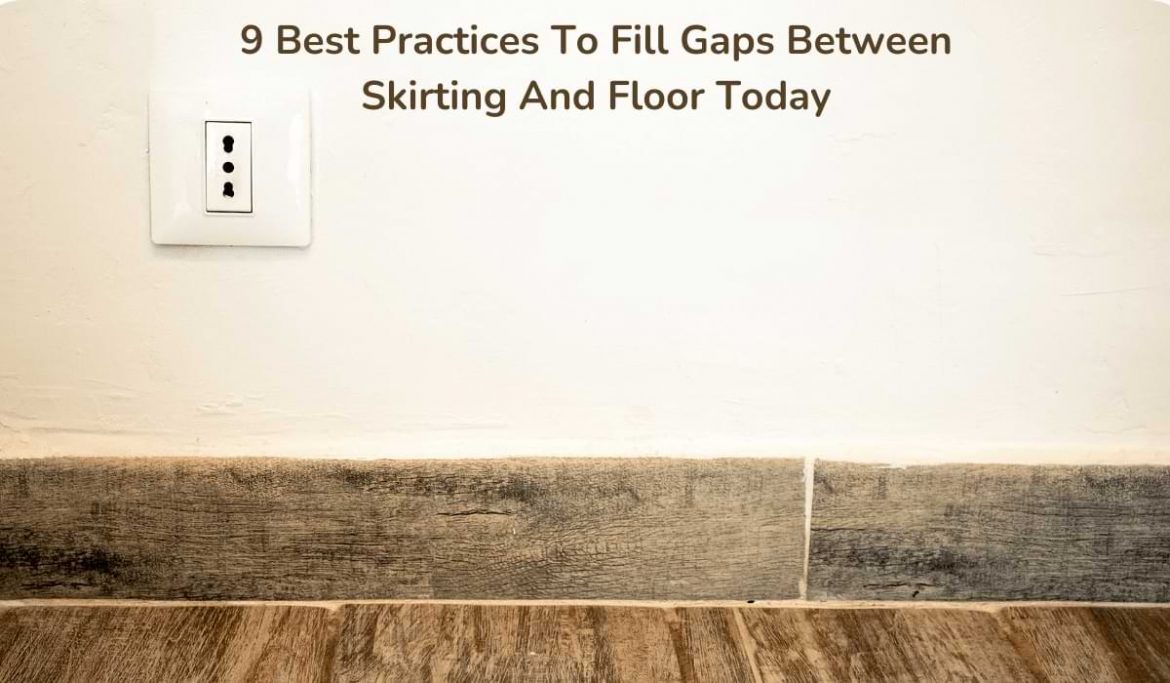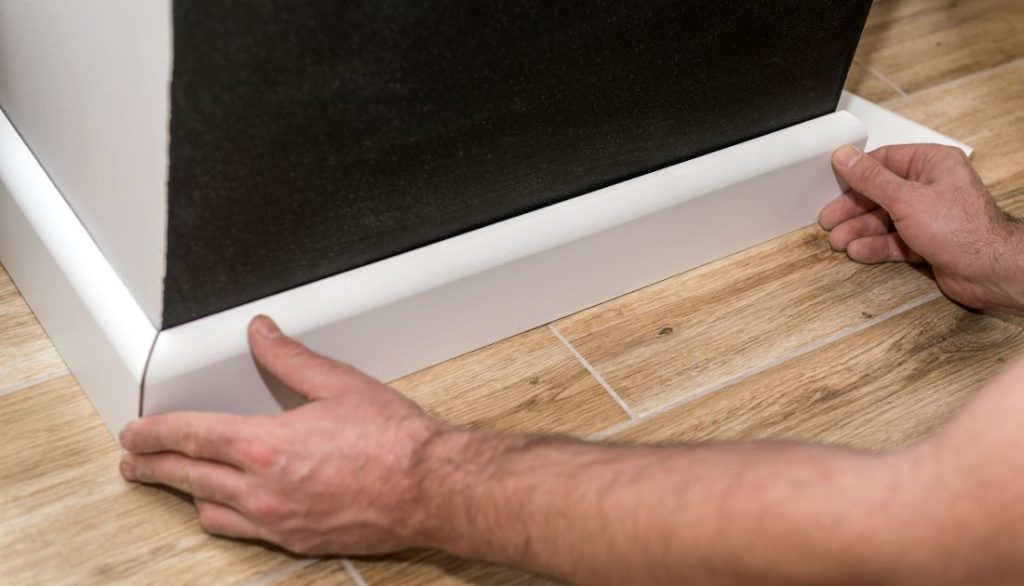Table of Contents
Inside your home, many elements work together to create the atmosphere you want. A well-designed layout can keep a sense of order and cohesiveness while encouraging air and light to flow through.
Adding skirting boards, flooring, wall coverings, and other finishing touches can give your space the look you want. Or they can create gaps that don’t serve any purpose but instead make your home feel cluttered.
With a little research and a few small changes to your layout, you can fill in those gaps between the skirting board and flooring. So that it doesn’t take away from the appearance of your space.
Large gap between skirting board and floor
Skirting boards are an essential element of interior design, providing a clean and cohesive finish to the junction between walls and floors. However, encountering a large gap between the skirting board and the floor can be unsightly and concerning for homeowners.
Whether you’re experiencing gaps due to settling foundations, poor installation, or other factors, understanding the root cause is crucial to implementing appropriate solutions that ensure long-lasting results.
How To Seal Between The Skirting And Floor?
- Clean the Area: Before sealing the gap, make sure to clean out any debris or dirt that may be present between the skirting and the floor.
- Choose a Sealant: Select an appropriate sealant for the job, such as silicone caulk or flexible filler, compatible with both surfaces.
- Apply Sealant: Using a caulking gun, carefully apply the sealant along the gap between the skirting board and floor in a continuous bead.
- Smooth Out: Use a wet finger or tool to smooth out the sealant and ensure it fills all gaps evenly.
- Allow to Dry: Let the sealant dry entirely per manufacturer instructions before painting over if desired.
Tools and Materials Needed:
- Caulk gun: This tool will be essential for applying the caulk to fill the gap between the skirting board and the floor. Choose a caulk gun that is easy to use and provides a steady flow.
- Painter’s tape: Painter’s tape helps you create clean, straight lines when applying the caulk. Use it to mask off areas around the skirting board to prevent accidental smudges or spills.
- Caulk: You will need a paintable acrylic caulk tube to fill the gap between the skirting board and the floor. Choose a color that matches your existing skirting board for a seamless finish.
- Sealant Gun: Use a sealant gun to apply the low modulus, neutral cure silicone into the gap between the skirting board and floor. This will help seal the area effectively.
- Stanley Knife or Blade: A Stanley knife or blade can cut neatly through excess silicone for a clean finish along the edges of the skirting board.
- Silicone Smoothing Tool: After applying the silicone, use a smoothing tool to create a professional-looking finish by smoothing out any bumps or uneven areas.
- Foam Backing Rod/ Strips: Fill larger gaps with foam backing rods or strips before applying silicone. This will provide additional support and insulation for a more secure seal.
Additional Supplies
- Spray Bottle of Washing-Up Liquid and Water: Mix water with washing-up liquid in a spray bottle to moisten your finger for easy silicone smoothing without it sticking.
- Kitchen Towel or Clean/Dry Cloth: Keep a kitchen towel or cloth nearby to wipe away any excess silicone that may spill over during application, ensuring a neat result.
1) Prepare The Area
- Clean the area: Before filling in the gap, it is essential to clean the space thoroughly. Dust and debris can prevent the filler from adhering properly.
- Use methylated spirit: Methylated spirit effectively cleans the surface, removing dirt or grease.
- Ensures proper adhesion: Using methylated spirit ensures the filler adheres well to both surfaces, creating a solid bond that lasts over time.
2) Load The Silicone Gun
- Prepare the silicone tube: Before loading the silicone gun, ensure that the silicone tube is ready for use. Cut off the tube tip at a 45-degree angle for smoother application.
- Insert the silicone tube into the gun: Insert one end into the gun’s nozzle, ensuring it fits securely.
- Prime and load: Squeeze the trigger until sealant appears at the nozzle base. Apply evenly along gaps or seams. The project fills a large gap between the skirting board and the floor.
3) Apply The Silicone Sealant
- Clean the gap: Before applying the silicone sealant, thoroughly clean the area between the skirting board and the floor. Use a vacuum or damp cloth to remove any dust, debris, or dirt that may be present.
- Cut the nozzle: Cut off the tip of the silicone sealant tube at a 45-degree angle using a utility knife. This will help you control the flow of sealant and ensure a smooth application.
- Apply sealant: Slowly squeeze out a bead of silicone sealant along the entire length of the gap between the skirting board and the floor. Use steady pressure to create an even line without gaps or bubbles.
- Smooth it out: Once you have applied the silicone sealant, use your finger or a caulking tool to smooth out any excess and create a neat finish. Allow sufficient time for drying as per the manufacturer’s instructions before moving furniture back into place.
4) Smooth The Sealant
- Apply pressure: After filling the gap with sealant, use your finger or a putty knife to firmly press down on the sealant. This will help smooth out any bumps or ridges in the sealant.
- Use a damp cloth: Once you have applied pressure and smoothed out the sealant as much as possible, take a wet cloth and gently wipe away any excess adhesive from the skirting board and floor. This will give your final finish a clean and polished look.
- Allow to dry: Finally, allow the sealant to dry completely before touching it or moving any furniture back into place. This will ensure that the sealant sets properly and provides a long-lasting solution for closing that pesky gap between your skirting board and floor.
5) Allow Sealant To Cure
- Follow Instructions: After applying the sealant to the gap between the skirting board and floor, allow it to cure completely according to the manufacturer’s instructions. This step is crucial for ensuring a strong, durable bond that effectively seals the gap.
- Avoid Disturbances: During this time, it is essential to avoid any disturbances or contact with the sealant. This includes refraining from walking on or touching the area where the adhesive has been applied, as any movement can disrupt the curing process.
- Patience is Key: Curing times may vary depending on the type of sealant used. It is essential to exercise patience and wait for the recommended duration before resuming normal activities in that area of your home.

large gap between skirting board and floor
Fill Gaps with Add Foam
The first way to fill gaps between skirting boards and flooring is foam. Foam is a great option because it can be cut to any shape or size and then primed and painted.
To apply foam, you need to use spray adhesive or liquid nails. If you’re looking for an economical alternative, purchase a pre-primed piece of foam from your hardware store.
Fill Gaps with Add Caulk
Gaps filling with caulk is a good idea because caulk has the properties of a good and long-lasting filler. In addition, it gives a fine appearance to the floor.
If you have gaps in your skirting boards, flooring, or wall covering, you can fill them with caulking. You can purchase caulk from a hardware or home improvement store.
You should be careful when applying the caulk, so it won’t seep and create an unsightly mess. Be sure to clean all surfaces and edges before applying the caulk and wipe away any excess.
Fill Gaps with Add Filler Material
A quick fix for gaps between the skirting board and flooring is to use filler material. Filler materials typically fill unwanted spaces around a home, such as a gap created by skirting boards and flooring.
The filler material can get painted or covered with wallpaper or other finishes to complete the look you want. When choosing a material for your filler, choose something with high contrast so the color difference will stand out more.
For example, if you want a white floor with a black skirting board, use dark-colored filler because the contrast will make the skirting board stick out more.
Add a Molding
It is beneficial to choose to mold for gap filling because it has a lower capital cost. Moldings fill the gaps between skirting boards and flooring, giving a clean, consistent look.
In addition, you may add trim or baseboard around the molding.
Use a Rug
Rugs are a great way to fill in these gaps, especially if you’re already using flooring that will take care of your skirting. Rugs come in all different colors and textures to match the mood of your home.
A neutral-colored rug can add an element of simplicity and contrast to the look of your space while also providing a place for you to place decorative pieces if you want.
Paint the Gap
First, you’ll want to paint the gap that you see. The easiest way to do this is with cheap acrylic paint. You can also use wall paint, which is more affordable than pre-mixed colors.
Once you have painted the gap, it will look as though there is no gap and there are no gaps between anything in your room. It will look like one continuous area instead of a few different elements that need to be glued together or filled in.
Another option would be to stain the floor and then lay a piece of wood over the stained surface. It would make a perfect finish for those hard-to-reach places.
Wood Filler
Wood filler is a great option for filling in gaps between skirting boards and flooring that doesn’t serve any purpose. Usually, this filler is a mixture of sawdust, water, glue, and other ingredients that hardens when it dries.
A wood filler can be applied to the gap between the skirting board and flooring, then taken care of with sandpaper after it dries. When you choose wood filler to fill in these gaps, you don’t have to worry about how it will look once it dries.
It temporarily replaces the gap with a color or pattern that matches your flooring or wall covering so you can get the look you want while also filling in the space.
The most important thing about wood filler is its ability to create a seamless finish that doesn’t leave any gaps or imperfections around your walls, so they appear as if they are floating on air.
When finished with a wood filler, it will feel like there never was anything there at all.
Piece of Cloth
People who want to fill the gap between skirting board and flooring can use a few small pieces of wood or rubber to create an even surface. To make this look more natural and elegant, you can use a piece of cloth as your base and then cover it with wood.
You can also use a few pieces of cardboard or plywood to cover the area that needs coverage. These materials are not only cheap but also easy to work with, so it’s an option for anyone who is in needs to fill that gap while staying on budget.
Vinyl Spacer Strips
If you’re looking for a quick way to fill those gaps between skirting boards or flooring, vinyl spacer strips are the answer. They can be installed directly over any opening, no matter how large, and they’ll stay in place until you decide to take them up.
When the spacer strips get removed, the floor underneath will look like it was never there. If you want an even more comprehensive and fine look, use spray paint on top of the spacer strip to make it match your wall color.
The best part about these little strips? You can use them for other objectives as well!
These versatile spacers have many uses that might help your home feel even more organized.

The Benefits Of Sealing Between The Skirting Boards And Floor
Prevents Dust and Debris Build-Up:
By sealing the gap between the skirting boards and floor, you can prevent dust, dirt, and other debris from collecting in that space. This helps keep your home cleaner and makes it easier to maintain a hygienic environment.
Improves Energy Efficiency:
Sealing the gap can help improve energy efficiency by preventing cold drafts from entering your home during winter. This can lead to lower heating bills and a more comfortable living space.
Enhances Aesthetic Appeal:
In addition to practical benefits, sealing the gap can enhance your home’s aesthetic appeal. Creating a seamless transition between the skirting boards and the floor can achieve a more polished and refined look in any room.
Improved Energy Efficiency
Filling the gap between the skirting board and the floor can drastically improve energy efficiency in your home.
You can prevent heat from escaping during colder months by sealing off any drafty areas.
Insulating this space helps maintain a consistent temperature within your living spaces, reducing the need for constant heating.
Reduced Draughts
A tight seal along the skirting board eliminates unwanted draughts that make rooms feel chilly and uncomfortable.
Closing off gaps prevents cold air from seeping through cracks, creating a more comfortable environment year-round.
Say goodbye to annoying drafts by addressing this common issue with simple insulation solutions.
Enhanced Insulation
Properly insulating around the skirting board reduces heat loss and enhances overall insulation in your home.
This small improvement can lead to significant energy savings over time as your heating system works more efficiently.
Enhancing insulation where needed most can help you enjoy a cozier living space and lower utility bills.
Pest Prevention
Sealing the gap between the skirting board and floor can help prevent pests like insects and rodents from entering your home.
By closing off this entry point, you create a barrier that deters unwanted visitors from making themselves at home in your space.
Improved Indoor Air Quality
A well-sealed room with no gaps between the skirting board and floor can help improve indoor air quality by preventing dust, debris, and other pollutants from entering through gaps. This can lead to a healthier living environment for you and your family.
Aesthetic Appeal
Closing the gap between the skirting board and floor provides functional benefits and improves the overall look of your living space.
A seamless finish creates a polished appearance that enhances the aesthetics of any room in your home.
Protection Against Moisture
Closing the gap between the skirting board and the floor can help prevent moisture from seeping into the walls and causing damage.
Moisture buildup can lead to mold growth, which poses health risks for building occupants.
By sealing off this gap, you can protect your home from water damage and maintain a healthy indoor environment.
Long-Term Cost Savings
Addressing gaps in your skirting board can save long-term costs by preventing costly repairs.
Water damage caused by moisture infiltration can lead to structural issues that require extensive and expensive repairs.
By taking action now to address this issue, you can avoid future repair costs and protect the value of your property.
Noise Reduction
A sealed skirting board helps reduce noise transmission between rooms, creating a quieter living environment.
Eliminating gaps prevents sound waves from traveling through walls and floors, improving overall acoustics in your home.
Enjoy a peaceful atmosphere by closing these gaps with a simple solution.
Preservation of Flooring Materials
Seal the gap: Fill the space between the skirting board and floor with caulk or sealant to prevent dust, debris, and insects from getting trapped in the crevice. This will also help maintain the integrity of your flooring material.
Regular cleaning: Vacuum or sweep the area around the skirting board regularly to keep it clean. This will prevent dirt and grime buildup that can potentially damage your flooring over time.
Monitor moisture levels: Excess moisture can cause wooden floors to warp or laminate floors to buckle. Always monitor humidity levels in your home and use dehumidifiers or fans as needed to maintain a healthy environment for your flooring materials.
Wrapping up
The article talks about how to fill in the gaps between skirting board and flooring.
There are many ways to fill the gaps between your skirting and floor.
Using one of the nine best practices mentioned in this article, you can create a seamless look that will improve the visual of your home. So don’t wait any longer – get started today!

